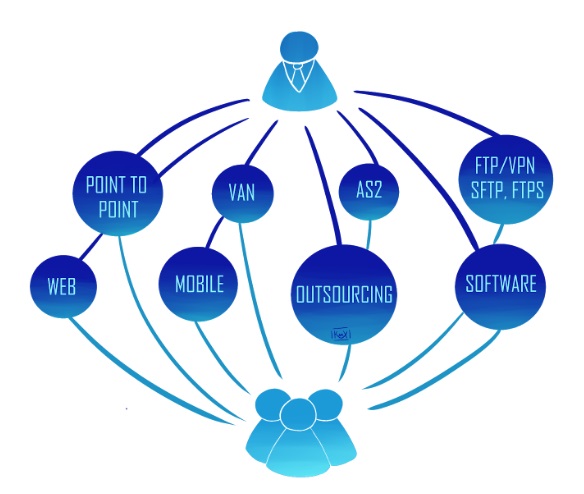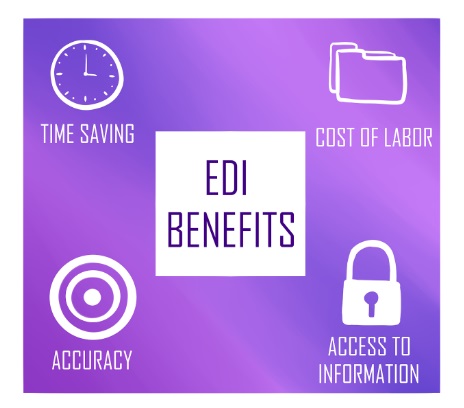EDI documents are based on specific EDI standards that define the rules for how the content of an EDI document is laid out. This document ensures that an EDI translator on the receiving end knows where to find each piece of information to convert the EDI document to the format of the receiver’s internal accounting system.
EDI document belongs to a specific transaction set. An EDI transaction set or T-set corresponds to one specific type of electronic business documents, such as an invoice or a purchase order. There are many different documents that you might exchange with your trading partners.
A transaction set, in turn, is composed of data elements, segments, and envelopes. EDI Transaction Set has data segments that came from the EDI’s unique bits of information. An example of which is a purchase order or an invoice where you will find data like the address (city, state, country), item number, the quantity of each item, and the price. Each EDI transaction set segment consists of a data element group. Buyer information, item details, document totals, and such are the group of related data that you would expect to see in a purchase order document. Each of these sections comprises a single segment.
The transmitted envelopes to your partner that have a completed EDI document or transaction set came from the completed segments collected into a recommended order. EDI transmission uses a system of three envelopes to house your transaction sets – Message envelope, Group envelope, and Interchange envelope. Just as paper business documents are sent in envelopes and it is possible to mail many documents in a single envelope. EDI documents are exchanged using several envelopes. Each EDI document is placed in its message envelope. A group of transaction sets – e.g., a group of purchase orders – is placed in a group envelope. All group envelopes being sent from one sender to one receiver are placed in an Interchange envelope.
Three processes to send EDI documents are – to prepare the documents, Decode the documents into EDI format, and Send the EDI documents to your trading partner.
- Prepare the Documents
Collecting and organizing the information. Make an electronic file with the collected information to build an EDI document instead of printing a purchase order.
- Decode the document to an EDI format
Using the proper segments and data elements, you need to supply your electronic data into a translator software that will turn your internal data format to an EDI standard format.
- Send the EDI documents to your trading partner.
After translating your business documents to a proper EDI standard format, then it is now available to be forwarded to your trading partner.
There are many ways you can select from on how to connect to each of your trading partners. The most common of which include:
- Directly using AS2 or a different secure internet protocol,
- EDI Network provider using your chosen communications protocol and count on the network provider to connect to your trading partners using whatever communications protocol your partners prefer.
- Combination of both, depending on each of your trading partners and the amount of transactions you anticipate to exchange.
Types of EDI
The most popular form of systematic exchange of business documents electronically is EDI – Electronic Data Interchange. There are different kinds of EDI and a variety of ways to use it across the trading environment. Be it that you are new to EDI or developing your existing EDI foundation to keep many different trading partners. There is a process of using EDI that will fit your business needs, technical capacities, and budget. Most large companies adopt hybrid EDI solutions to connect with trading partners.
- Direct EDI/ Point-to-Point EDI
In the direct connection method, you connect with your trading partner directly by the Internet using the same communication system or protocol. This can be very complicated and may require significant system resources if other trading partners are using different communication protocols. Your system must be capable of supporting all of these different, required protocols.
Large companies that have trading partners with whom they exchange a large amount of EDI documents use this method.
- EDI by VAN (Value Added Network) or EDI Network Service Provider
Another option to the direct EDI method is an EDI Network Services Provider, referred to as Value-Added Network (VAN), before the internet arises. Many companies choose this network type to keep them safe with the ongoing complicatedness of supporting the different communication protocols demanded by various trading partners.
- EDI by AS2
AS2 is an Internet communications protocol that permits data to be communicated securely over the Internet. EDI via AS2 gives the functionality of EDI with the universality of Internet access.
- EDI by FTP/VPN, SFTP, FTPS
The generally used communication protocol for EDI documents exchange by the Internet is FTP over VPN, SFTP, and FTPS. These types can connect straight to your trading partner (Direct EDI) or by EDI Network Service Provider.
- Web EDI
Web EDI administers EDI using a standard Internet browser, not like the EDI by AS2. Businesses use various online forms to exchange data with trading partners. Web EDI makes EDI manageable and affordable for small and medium-sized companies and those that have only special needs to use such a service.
- Mobile EDI
Conventional users access EDI by a private network like VAN or the Internet to send and receive EDI documents. Because of security reasons with mobile devices across an EDI foundation mainly of limitations with the mobile devices available, Mobile EDI has limited permission. The screen quality and size of devices do not fit. Still, there is a growing industry developing software applications for downloading to mobile devices. Hence, you have to wait before you can download supply chain and EDI related apps from private or corporate app stores.
- EDI Outsourcing
Known as B2B Managed Services and B2B Outsourcing is a fast-growing alternative that allows businesses to have an external specialist resource to manage their EDI environment regularly. This method is driven by enterprises requiring to integrate into back-office business systems like the Enterprise Resource Planning (ERP) principles. Many businesses do not want to use their internal resources to handle this ongoing type of work; that is why they outsource.
- EDI Software
Executing EDI software back at a business firewall is seldom a favored option. This method believes that a business has the proper internal support to implement the software and manage it regularly.
EDI BENEFITS (PAPER TO PAPERLESS)
To answer the problems deep-rooted in paper-based transaction processing and other types of electronic communication, EDI was developed. It is a tool that allows companies to restructure data flows and business processes. It directly answers several issues related to paper-based trade systems.
- Time-Saving—Paper documents take days to ship from one location to another, while manual processing procedure constrains steps like encoding, which is unnecessary through EDI.
- Cost of Labor—Data encoding, document filing, sorting, reconciling, envelope stuffing, stamping, signing, and likes are essential for Manual Processing. While electronic tools can help with some of these methods, most managers will agree that the cost of labor for document processing embodies a vital proportion of their expenses than with EDI alternatives.
- Accuracy—EDI systems are more accurate and efficient than manual processing because there are fewer cases at which errors occur in the system.
- Access to Information—EDI systems allow multiple users access to a large amount of detailed transaction data on time. In a manual processing environment, wherein information is in their offices, and filing cabinets, such distribution of information is feasible only with exceptional effort. It is incomparable to an EDI system’s timeliness as its data is already in computer-retrievable form, and made to automate processing and report; and requires less amount of space for storage.


